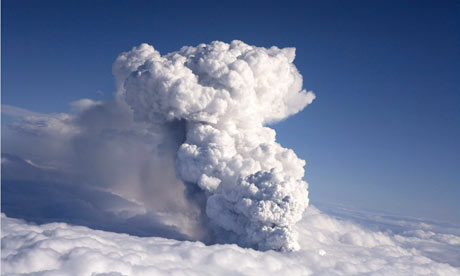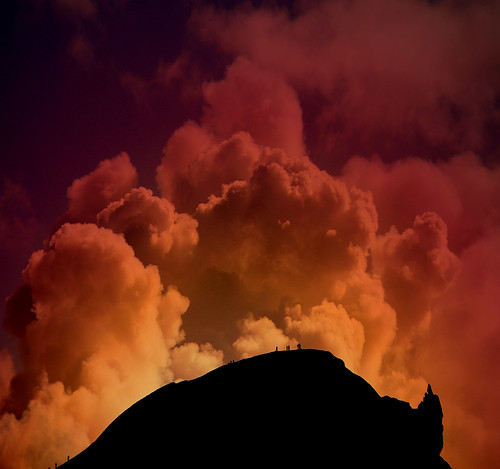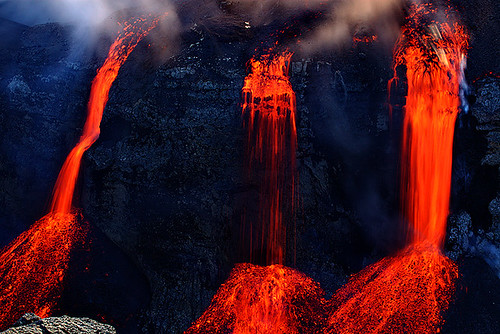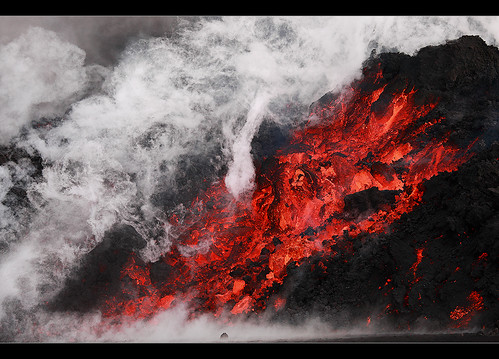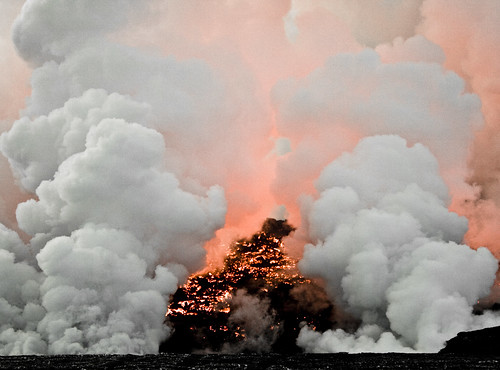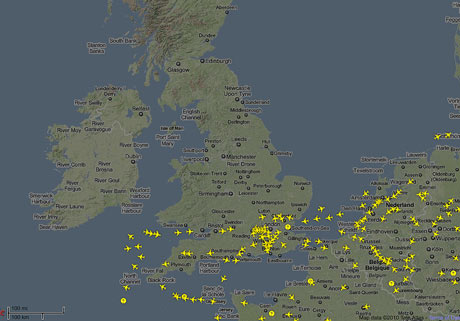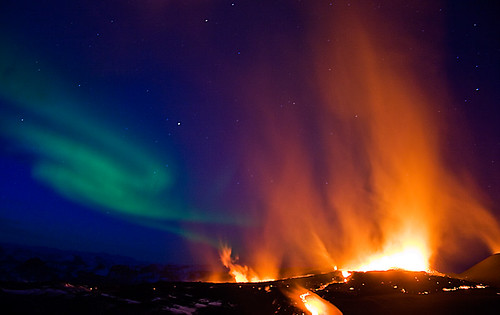This is the begining of the end...mrklaw said:my famiies flight back from japan just got bumped. All outbound flights from the UK are grounded, all Scottish airports closed :/
You are using an out of date browser. It may not display this or other websites correctly.
You should upgrade or use an alternative browser.
You should upgrade or use an alternative browser.
Volcano erupts in Iceland, hundreds evacuated
- Thread starter NotWii
- Start date
- Status
- Not open for further replies.
It's like the northern vagina of the earth
gofreak said:Wee! Irish airspace closed from 12-8 today.
I wonder if we'll be able to actually see anything. Or if it's just a thin spread of dust high in the atmosphere.
Cock!! Friend of mine was meant to be flying today, oh well!
GasProblem
Member
All flights to and from Heathrow are cancelled. And the Dutch weather institute KNMI says we'll have an unusually bright red sunset tomorrow because of the ash.
This is a cool site:
http://www.flightradar24.com/
Can see all the flights over an area at the moment. There's only a single flight in the air over Ireland right now :lol Relatively very few over Britain also, all in and out of London.
Also, this is a forecast of the dust's travel from the Icelandic met office (via the UK met office):

And a pretty picture:

http://www.flightradar24.com/
Can see all the flights over an area at the moment. There's only a single flight in the air over Ireland right now :lol Relatively very few over Britain also, all in and out of London.
Also, this is a forecast of the dust's travel from the Icelandic met office (via the UK met office):

And a pretty picture:

Keyser Soze
Member
UK airspace shut down from 12pm to 6pm
http://www.nats.co.uk/
http://www.nats.co.uk/
Red Scarlet
Member
Hope you make your flight, Gas. And hope everyone is ok in the affected areas.
GasProblem said:My Amsterdam-New York flight departs at 17:35, I really hope it isn't going to be canceled. I'm expacting a delay at least, because flight to the US have to take a detour now. Sigh, stupid volcano, can't you just spew out pwetty lava without the nasty ash clouds?
Volcanic ash is serious business.
Let's put it this way- I do weather observations. The priority for reporting volcanic ash is higher then tornados, and it will shut down airports 100% until it is fixed. The only thing probably more dangerous for airplanes to fly into are tornados and rotor clouds.
I didn't see VA in any of the TAF's (yeah, I'm geek enough to check)-then again weathermen can't forecast volcanos erupting.
FRESH MOUNTAIN DOOMnavanman said:
Keyser Soze
Member
Just heard on the news that if a plane goes through the ash it can make it's engines cut out instantly, which is obviously bad. Even worse though, even if the pilot gets them going again they are likely to only work at a "high diminished capacity" EEK!
I feel sorry for customer service at airports today, they will get all the anger for people missing their flights when they really should not (this time at least) :/
I feel sorry for customer service at airports today, they will get all the anger for people missing their flights when they really should not (this time at least) :/
Keyser Soze said:Just heard on the news that if a plane goes through the ash it can make it's engines cut out instantly, which is obviously bad. Even worse though, even if the pilot gets them going again they are likely to only work at a "high diminished capacity" EEK!
I feel sorry for customer service at airports today, they will get all the anger for people missing their flights when they really should not (this time at least) :/
it happened way back in 1982 - BA 747 had all four engines cut out flying through an ash plume
luckily they managed to restart them when they cleared the cloud.
One silver lining with my family being delayed - our new bathroom might actually be finished by then
Video of the flood at the mountain:
http://visir.is/article/20100414/FRETTIR01/366638533
Just think if you were camping somewhere at the plain...
http://visir.is/article/20100414/FRETTIR01/366638533
Just think if you were camping somewhere at the plain...
According to UK Air Traffic Controller, the volcanic eruption is still on-going.
The disruption to air traffic across Northern & Western Europe is severe with all air-space closed in Ireland, UK, Norway, Denmark & Sweden until at least 18:00 this evening.
The disruption to air traffic across Northern & Western Europe is severe with all air-space closed in Ireland, UK, Norway, Denmark & Sweden until at least 18:00 this evening.
mrklaw said:
Isn't it depressing for this guy to think, wow I went all the way to a remote region of Iceland, and put myself in danger just so some weeaboo nerds can have this as a desktop wallpaper for a week before changing it to some "rad" Deathnote art.
Meadows said:Isn't it depressing for this guy to think, wow I went all the way to a remote region of Iceland, and put myself in danger just so some weeaboo nerds can have this as a desktop wallpaper for a week before changing it to some "rad" Deathnote art.
Wat...
Any new dust travel forecasts? Just heard on the radio that Germany will also shut down their air traffic.gofreak said:Also, this is a forecast of the dust's travel from the Icelandic met office (via the UK met office):
EDIT: Found it. If this eruption wont stop, all EU air traffic could be grounded for several days

Copycat_Wannabe
Member
All air traffic will be shut down 22.00 today in Sweden, it has already been shut down in northern Sweden.
We've been having such nice weather lately. There is some serious wind coming this weekend so I guess we'll get it soon enough.Peru said:The strong sulfur smell has reached us here in western Norway.
Goldrusher
Member
A quarter of Europe's airports are now closed.
Pretty much all of them in the UK, Ireland, Belgium, Netherlands, Germany, Norway, Sweden and Denmark.
Pretty much all of them in the UK, Ireland, Belgium, Netherlands, Germany, Norway, Sweden and Denmark.
Just incase anyone is wondering why this drastic action is being taken, here is the Wikipedia entry of BA Flight 9 that flew through ash cloud in 1982.
Shortly after 13:40 UTC (20:40 Jakarta time) above the Indian Ocean, south of Java, the flight crew (consisting of Senior First Officer Roger Greaves and Senior Engineer Officer Barry Townley-Freeman while Captain Eric Moody was in the lavatory) first noted an effect on the windscreen similar to St. Elmo's fire. The phenomenon persisted after Captain Eric Moody returned from the lavatory. Despite the weather radar showing clear skies, the crew switched on engine anti-ice and the passenger seat belt signs as a precaution.
As the flight progressed, smoke began to gather throughout the passenger cabin of the aircraft and it was at first assumed to be cigarette smoke. However, it soon began to grow thicker and had an ominous odour of sulphur. Passengers who had a view out of the aircraft windows noted that the engines were unusually bright with the light shining forward through the fan blades and producing a stroboscopic effect.
At approximately 13:42 UTC (20:42 Jakarta time), engine number four began surging and soon flamed out. The flight crew immediately performed the engine shutdown drill, quickly cutting off fuel supply and arming the fire extinguishers. Less than a minute later, at 13:43 UTC (20:43 Jakarta time), engine two surged and flamed out. Within seconds, and almost simultaneously, engines one and three flamed out prompting the flight engineer to exclaim, "I don't believe it all four engines have failed!"
Without engine thrust, a 747-200 has a glide ratio of approximately 15:1 meaning it can glide forward 15 kilometres for every kilometre it drops. The flight crew quickly determined that the aircraft was capable of gliding for 23 minutes and covering 91 nautical miles (169 km) from its flight level of 11,000 metres (36,000 ft). At 13:44 UTC (20:44 Jakarta time), First Officer Roger Greaves declared an emergency to the local air traffic control authority, stating that all four engines had failed. However, Jakarta Area Control misunderstood the message; interpreting the call as meaning that only engine number four had shut down. It was only after a nearby Garuda Indonesia flight relayed the message to Air Traffic Control that it was understood. Despite the crew squawking the emergency Transponder setting of 7700, the aeroplane could not be located by Air Traffic Control on their radar screens.
Many passengers wrote notes to relatives. One such passenger was Charles Capewell who wrote "Ma. In trouble. Plane going down. Will do best for boys. We love you. Sorry. Pa XXX" scrawled on the cover of his ticket wallet.
Due to the high Indonesian mountains on the south coast of the island of Java, an altitude of at least 3,500 metres (11,500 ft) was required to cross the coast safely. The crew decided that if the aircraft was unable to maintain altitude by the time they reached 3,650 metres (11,980 ft) they would turn back out to sea and attempt to ditch into the Indian Ocean. The crew began the engine restart drills, despite being well above the recommended maximum engine in-flight start envelope altitude of 8,500 metres (27,900 ft). The attempts failed.
Despite the lack of time, Captain Eric Moody made an announcement to the passengers that has been described as "a masterpiece of understatement":
Ladies and Gentlemen, this is your Captain speaking. We have a small problem. All four engines have stopped. We are doing our damnedest to get them under control. I trust you are not in too much distress.
As pressure within the cabin fell, oxygen masks dropped from the ceiling - an automatic emergency measure to make up for the lack of air. On the flight deck however, First Officer Roger Greves mask was broken; the delivery tube had detached from the rest of the mask. Captain Moody swiftly decided to descend at 1,800 m per minute to an altitude where there was enough oxygen in the outside atmosphere to breathe almost normally.
At 4,100 metres (13,500 feet), they were approaching the altitude at which they would have to turn over the ocean and attempt a risky ditching. Although there were guidelines for the procedure, no one had ever tried it in a Boeing 747 nor have they since. As they performed the engine-restart procedure, engine number four started, and at 13:56 UTC (20:56 Jakarta time), Captain Moody used its power to reduce the rate of descent. Shortly thereafter, engine three restarted, allowing him to climb slowly. Shortly after that, engines one and two successfully restarted as well. The crew subsequently requested and expedited an increase in altitude to 4,500 metres (14,800 ft) in order to clear the high mountains of Indonesia.
As the aircraft approached its target altitude, the St. Elmo's fire effect on the windscreen returned. Captain Moody throttled back, however engine number two surged again and had to be shut down. The crew immediately descended and held 3,600 metres (11,800 ft).
As Flight 9 approached Jakarta, the crew found it difficult to see anything through the windscreen, and had to make the approach almost entirely on instruments, despite reports of good visibility. The crew decided to fly the ILS, Instrument Landing System, however, the glideslope was inoperative, so they flew the localizer as the first officer monitored the airport's DME (Distance Measuring Equipment). He then called out how high they should be at each DME step along the final track to the runway, creating a virtual glide slope for them to follow. It was, in the words of Captain Moody, "a bit like negotiating one's way up a badger's arse".[1] Although the runway lights could be made out through a small strip of the windscreen, the landing lights on the aircraft seemed to be inoperable. After landing, the flight crew found it impossible to taxi, due to glare from apron floodlights which made the already sandblasted windscreen opaque. Therefore, City of Edinburgh had to wait for an airport tug to tow her in.
Winterblink
Member
Dat ash.
If eruption suddenly stops, otherwise you will probably stay grounded.gofreak said:I've a flight on Sunday, that I really need to make. I assume this will be well cleared up by then?
Wes said:This'll be the backdrop to a future movie poster.
orange and blue
a 747-200 has a glide ratio of approximately 15:1 meaning it can glide forward 15 kilometres for every kilometre it drops.
thats really impressive. And that report is v.scary to read
DrM said:If eruption suddenly stops, otherwise you will probably stay grounded.
Well...how long do eruptions normally last? :S
I'm not liking that latest update about traffic halted til 6am tomorrow, now.
Meadows said:All flights prohibited from UK airspace until at least 0600 tomorrow - NATS
This is a mare for me. My family is coming from Tokyo, which is an 11 hour flight. So before they even decide to take off they'll need to know the airspace is clear. With this rolling ban in place it'll probably be at least the weekend until they can get back.
In honour of these events, I feel like watching a volcano movie. Are there actually any good ones? Dante's peak and Volcano were shitty. Was there an earlier 70's Volcano movie? How about Joe and the Volcano?
oh, and BBC 6 music have Ash in session tonight
gofreak said:Well...how long do eruptions normally last? :S
I'm not liking that latest update about traffic halted til 6am tomorrow, now.
assume you're fucked but at least be grateful you're fucked at home and not stranded trying to get back.
SlasherJPC
Banned
I don't plan on going to the UK till September but still this is damn scary! Hope the best for everyone.
mrklaw said:How about Joe and the Volcano?
.
The first 15 minutes are great, where they set up the mundane life of the main character (played by Hanks). But once he gets to the volcano it turns into a slapstick comedy that isn't very funny.
mrklaw said:assume you're fucked but at least be grateful you're fucked at home and not stranded trying to get back.
Wonder if your family's insurance will cover hotel etc. expenses while they wait? Must be shitty, but hopefully they can be told a time to come back, and then go off and enjoy some more time there at someone else's expense...
TBH, I don't mind if I can't travel Sunday - I could do without this trip - but other people will be very pissed off if I'm not over there next week.
Now that I've said that, the skies will miraculously clear and I'll have to go 
MechaGodzilla
Neo Member
To How About No
If your home was being evacuated due to a volcano, and the lava destroyed everything, would you still be in awe at how cool it looks?
Forgot to hit the quote button oops
Actually when my home in New Olreans was flooded by Katrina I actually was in awe of the storm and the water. It was sad but I lived so I was thankful to get out with what have which are my family and friends, everything else will comeback eventually and it has. This definitely sad for those people that had to leave and are losing their homes but it is still cool to see such an event.
If your home was being evacuated due to a volcano, and the lava destroyed everything, would you still be in awe at how cool it looks?
Forgot to hit the quote button oops
Actually when my home in New Olreans was flooded by Katrina I actually was in awe of the storm and the water. It was sad but I lived so I was thankful to get out with what have which are my family and friends, everything else will comeback eventually and it has. This definitely sad for those people that had to leave and are losing their homes but it is still cool to see such an event.
http://www.rte.ie/news/2010/0415/travel.html
Hmmm.
The Irish Aviation Authority has been told by the Volcanic Ash Plan Advisory Centre in London that the plume is likely to grow in size tomorrow and remain over Northern Europe.
A spokesperson said it is likely that the ash will encroach further into Irish airspace tomorrow.
Hmmm.
My folks have a holiday planned and a flight to Spain on Sunday (From Gatwick), am i right in thinking theres no chance the flight will go 
They worked all year for it last year and insurance wont cover this at all
They worked all year for it last year and insurance wont cover this at all
- Status
- Not open for further replies.


